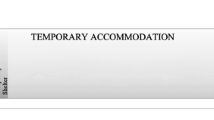Abstract
In this chapter, we would like to discuss the current situation 5 years after the GEJE, mainly from the viewpoint of housing reconstruction. There are 160,000 people who were evacuated from their hometowns still without having their own houses, and 50,000 people living in prefabricated or wooden temporary housing. Three types of temporary housing were provided, namely, prefab housing, wooden housing and rental-apartment housing. The prefab temporary housing had many problems in terms of quality of life and cost. The wooden temporary housing was a new innovation and had good quality and low cost; additionally, their construction in each damaged area with local materials and local workers was helpful to the local economy. The victims welcomed the temporary rental apartments and housing, but the system had a few problems related to the process of assignment. There are two ways to get permanent housing after temporary housing, one is through the reconstruction of public housing and the other is self-reconstruction. The public-housing completion rate is 60% of the suggested plan. While the public housing system is very important for low-income victims, we should not totally rely on the system because it has some demerits. The self-reconstruction way is natural for the local victims to follow. The support system should be strengthened so that it takes assumes a larger part of housing reconstruction. In the Tohoku area, housing reconstruction is linked to reconstruction machidukuri project, which involves a very complicated process and takes very much time. Japan is now facing not only reconstruction from the GEJE but also preparation for the next huge disaster in the near future, therefore it is crucial to make every kind of preparation by learning from past experiences. One of the important points to be considered is to set up a permanent special organization to learn the entire lesson and to improve the system for the reduction of disaster damage overall.
Access this chapter
Tax calculation will be finalised at checkout
Purchases are for personal use only
Similar content being viewed by others
References
Asahi Shimbun –newspaper (2016a) 18 February, In Japanese. http://www.asahi.com/articles/ASJ285QRNJ28UTIL03Q.html. Accessed Sept 2016
Asahi Shimbun – newspaper (2016b) 7 March, In Japanese. http://digital.asahi.com/articles/DA3S12245021.html
Cabinet Office 2016 In Japanese. Accessed Sept 2016
Iwate Nippo newspaper 7 March 2016, In Japanese. http://www.iwate-np.co.jp/cgi-bin/news.cgi?sh=20160307_1
Iwate prefecture web sites In Japanese. http://www.pref.iwate.jp/dbps_data/_material_/_files/000/000/023/870/280630kasetu06.pdf. Accessed Sept 2016
Kamei H (2014) Setting up and current situation of Act on Support for Reconstruction Livelihood of Disaster Victims. In: Critique of act on support for reconstruction livelihood of disaster victims. Institute of Disaster Area Revitalization, Regrowth and Governance, Kwansei Gakuin University, Japan, p 3–5
Fumitake MENO (2013) Actual situations of housing lease program for disaster victims in Sendai City – a questionnaire survey of residents after the Great East Japan Earthquake. J Archit Build Sci AIJ 78(689):1589–1596
Ministry of Health, Labor and Welfare, 18 March 2016, In Japanese. http://www.mhlw.go.jp/wp/hakusyo/jisatsu/16-2/dl/1-09.pdf
Ministry of Land and Transportation 13 May 2014, In Japanese. https://www.judanren.or.jp/admin/pdf/h260513_mlit-data01.pdf
Matsukawa A, Tujioka A, Tatsuki S (2015) Life recovery and the challenges of four types of dwellers. Life recovery assessment workshop in Natori City in Miyagi prefecture. J Soc Saf Sci, No.25, 2015.3 and http://isss.jp.net/isss-site/wp-content/uploads/2015/03/2014-035.pdf (in Japanese)
Reconstruction Agency (2016, June 30) In Japanese. http://www.reconstruction.go.jp/topics/main-cat1/sub-cat1-15/20160630_jutakukyokyuu.pdf
Shiozaki Y (2014) Reconstruction disaster. Iwanami Shoten Company, Tokyo
Takeda K (2014) The Noto-Peninsula earthquake- experience in Wajima City. In: Critique of act on support for reconstruction livelihood of disaster victims. Institute of Disaster Area Revitalization, Regrowth and Governance, Kwansei Gakuin University, Japan, p 63–70
Author information
Authors and Affiliations
Corresponding author
Editor information
Editors and Affiliations
Rights and permissions
Copyright information
© 2018 Springer International Publishing AG
About this chapter
Cite this chapter
Shiozaki, Y. (2018). Housing and Reconstruction over the Five Years After the 2011 Japan Earthquake and Tsunami. In: Santiago-Fandiño, V., Sato, S., Maki, N., Iuchi, K. (eds) The 2011 Japan Earthquake and Tsunami: Reconstruction and Restoration. Advances in Natural and Technological Hazards Research, vol 47. Springer, Cham. https://doi.org/10.1007/978-3-319-58691-5_11
Download citation
DOI: https://doi.org/10.1007/978-3-319-58691-5_11
Published:
Publisher Name: Springer, Cham
Print ISBN: 978-3-319-58690-8
Online ISBN: 978-3-319-58691-5
eBook Packages: Earth and Environmental ScienceEarth and Environmental Science (R0)




